Ultra wide angle lenses for shooting landscapes and architecture.
If you’re planning to buy a camera that supports interchangeable lenses, you’ll need to know what types of lenses you’ll have to add to your gear. While having a DSLR or mirrorless camera is great on its own, you won’t be able to use their capabilities to the maximum if you don’t pair them with different lens types, for example a wide angle lens.
The sad reality is that most camera owners never move past their kit lens, which makes the purchase of an interchangeable-lens camera seem entirely pointless. What’s even sadder is that they never discover how much the quality of their photos can be improved by using the right lens at the right time.
If you want to avoid that mistake and are looking for some new optics for your camera, then check out this review of the best wide angle lenses below.
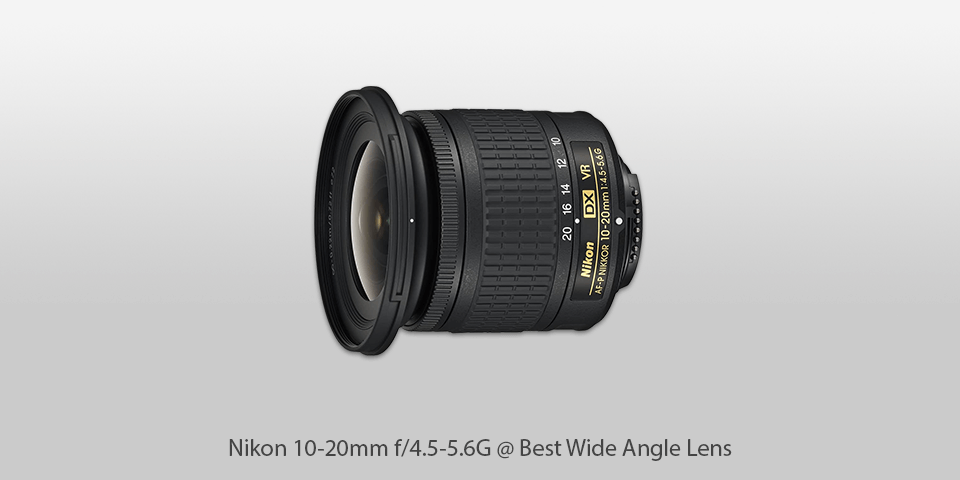
Mount: AF | Diaphragm blades: 7 | Autofocus: good | Min focus distance:0.22 m | Max magnification: 0.17x | Filter thread: 72 mm | Dimensions (WxL): 20mm | Weight: 0.51 lbs
⊕ Lightweight and small
⊕ Extremely large angle of view coverage
⊕ High sharpness
⊖ Some barrel distortion
Despite its extra-small, featherweight build, the Nikon 10-20mm f/4.5-5.6G offers incredible performance, which makes it easily one of the best wide angle lenses around. The implemented vibration reduction system allows the lens to produce sharper handheld images and videos and enables you to set slower shutter speeds to take brighter pictures in poor lighting conditions.
Equipped with 3 aspherical lens components, the 10-20mm f/4.5-5.6G minimizes distortions and helps maintain the featherweight, compact build. The super integrated coating (SIC) deals with ghosting and flares in backlit shooting conditions, while ensuring the colors look natural and contrast stays high. The 7-blade aperture adds a soft blur to the background, which is great for focusing the viewer's attention on the subject.
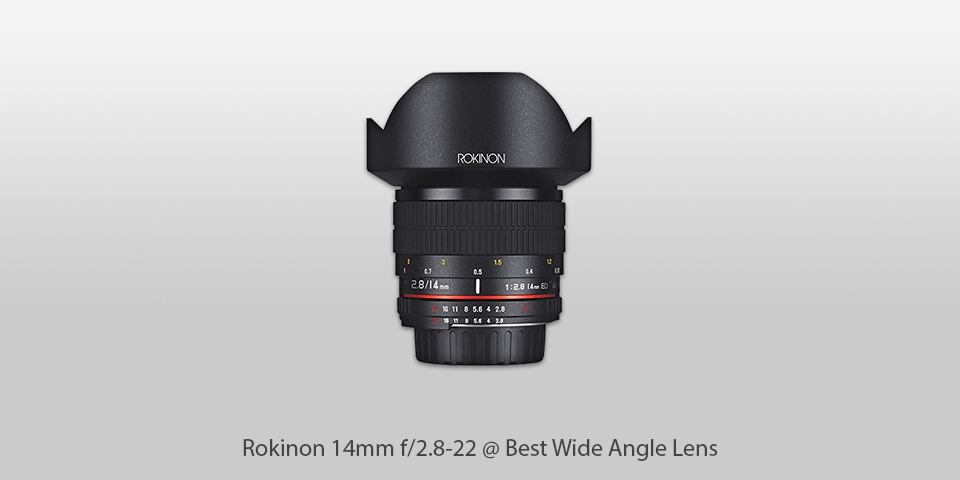
Mount: EF | Diaphragm blades:6 | Autofocus: good | Min focus distance: 0.9 m | Max magnification:0.14 x | Filter thread:14 mm | Dimensions (WxL):14 mm | Weight: 1.20 lbs
⊕ Strengths of a prime lens
⊕ Professional-grade optical elements
⊕ Minimum flare and ghosting
⊖ None
The Rokinon 14mm f/2.8-22 is a wide angle lens that shares many of the features found in its predecessor – the 14mm F/2.8 ultra-wide-angle lens for Canon cameras. In addition to those characteristics, this model offers an integrated AE for automatic metering. It enables you to use the camera for automatically choosing the optimal aperture and exposure settings in any shooting conditions. The lens is made by a reputable brand and offers high durability, top-notch build quality, and terrific performance while being offered at a reasonable price.
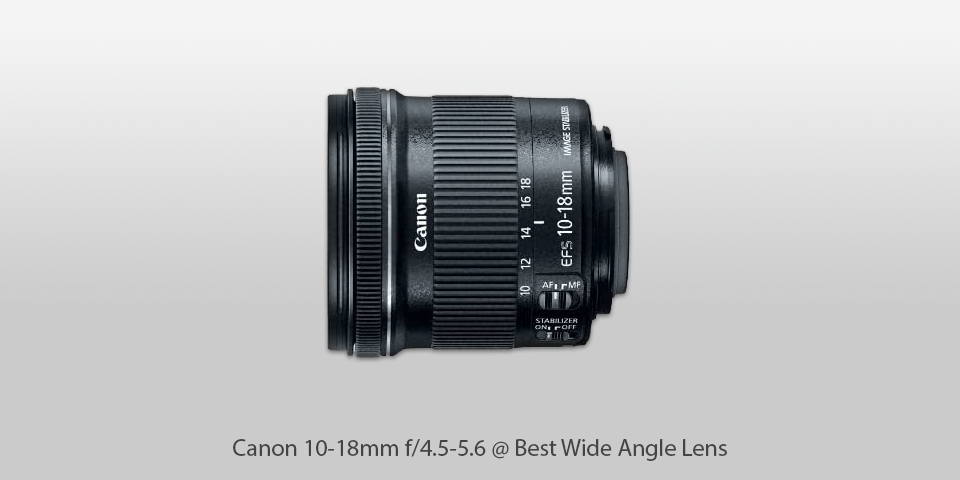
Mount:EF | Diaphragm blades:7 | Autofocus:good | Min focus distance: 200mm | Max magnification: 0.15x | Filter thread: 18mm | Dimensions (WxL): 18mm | Weight: 0.53 lbs
⊕ Great sharpness on the entire range
⊕ Attractive price
⊕ Ultra-wide angle FoV
⊖ Noticeable color fringing
If you’re looking for super wide angle lenses for your EOS APS-C sensor camera, this is the ideal option for you. The Canon 10-18mm f/4.5-5.6 offers great performance, small size, portable packaging, a 4-group optical zoom, a large-diameter component, an aspherical lens component, a UD lens component, and improved coatings – all serving to produce a high-contrast, detailed picture with virtually non-existent glare and aberrations.
The lens is supplied with a 7-blade aperture that adds a nice backdrop blur, while the optical image stabilizer offers up to 4 stops of camera shake minimization. The 10-18mm f/4.5-5.6 comes with a stepping motor STM and a state-of-the-art focusing system that ensures the autofocus works smoothly when recording any kind of footage. Considered one of the top wide-angle lenses for Canon, the 10-18mm f/4.5-5.6 provides versatility and exceptional image quality for photographers seeking an impressive wide-angle option.
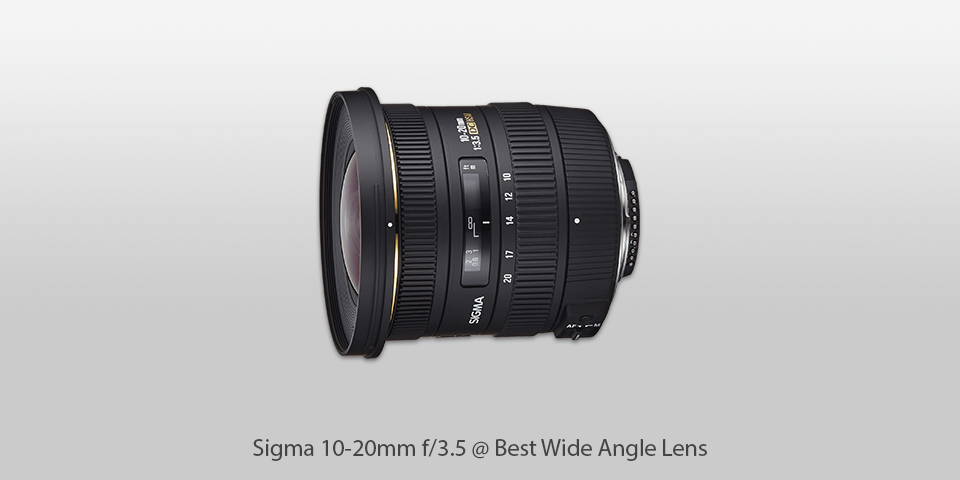
Mount: DC | Diaphragm blades: 7 | Autofocus:good | Min focus distance: 24cm | Max magnification: 0.15× | Filter thread: 10mm | Dimensions (WxL):20 mm | Weight: 1.15 lbs
⊕ Nice viewing angle
⊕ High focusing speed
⊕ Design quality
⊖ Backlight
The Sigma 10-29mm f/3.5 offers a minimum focusing distance of 24 centimeters (about 9"") on the entire zoom range. Such a small distance on a wide-angle model enables you to take high-quality photos of both the main subject and the background scenery. The lens has a built-in focusing mechanism that removes the necessity of lens rotation, making it well-suited for using the provided petal-like hood that eliminates unnecessary light. This is one of the few ultra wide angle lenses that allow you to establish an exaggerated perspective of the subject and the background to highlight specific parts of the shot.

Mount: G | Diaphragm blades: 7| Autofocus: good | Min focus distance: 25 cm | Max magnification: 0.17x | Filter thread:12 mm | Dimensions (WxL): 35 mm | Weight: 1.00 lbs
⊕ MTF chart describes the optical performance
⊕ Min reflections thanks to Nano coating
⊕ Freeze-proof, weather-resistant build
⊖ None
The Panasonic 12-35mm F/2.8 is among the best wide angle lenses for the Micro Four Thirds system. It offers terrific optical performance for both enthusiasts and professional photographers. The lens comes with the brand's signature Nano surface coating that minimizes reflections across the light spectrum, allowing you to enjoy maximum detail and sharpness.
One of its standout features is the 12-35mm focal length, providing a versatile wide to standard zoom range. This flexibility makes it an ideal choice for capturing landscapes, architecture, group shots, and even portraits, offering a wide perspective without sacrificing detail or clarity. Designed for outdoor photography, the Panasonic 12.35mm F/2.8 comes in a metal body with a weather-resistant design when attached to a LUMIX G mirrorless camera.
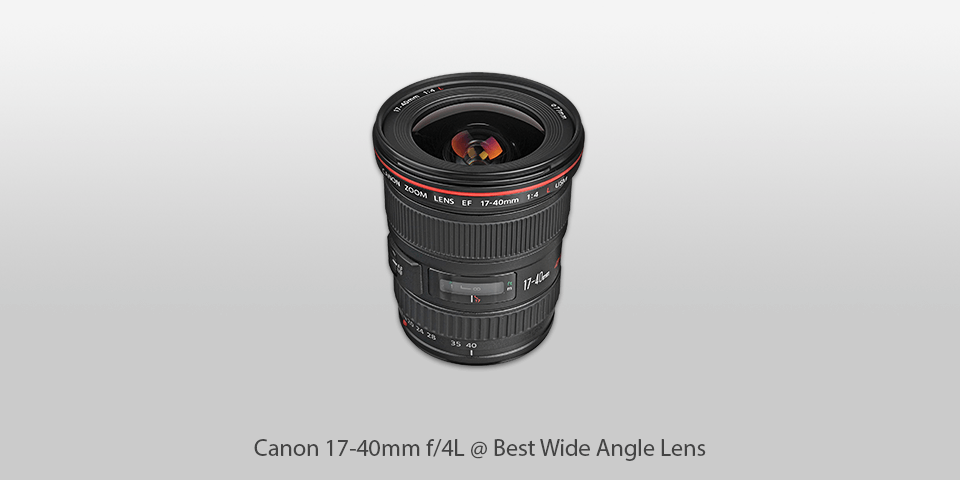
Mount: EF| Diaphragm blades: 7| Autofocus:good | Min focus distance: 28cm | Max magnification:0.17 x | Filter thread: 35 mm | Dimensions (WxL): 40 mm | Weight: 1.10 lbs
⊕ Ultra-wide FoV
⊕ Cheaper than most competing lenses
⊕ Impressive center sharpness
⊖ Minor distortions
Expand your perspective with this ultra wide zoom lens. Canon 17-40mm f/4L is perfectly suited for both film cameras and DSLRs and is supplied with 3 aspherical components as well as an ultra-low dispersion glass component, allowing you to perform well in any shooting conditions. Additionally, the lens can focus on subjects as near as 11"" and comes with Canon's manual focusing and autofocusing modes.
The autofocus is powered by a ring ultrasonic motor that ensures you enjoy high speed and precision. The lens also supports a constant f/4 max aperture and lets you pick between attachable 77mm filters and a holder at the back of the lens for up to 3 gel filters. Sporting weather-resistant properties akin to other premium L-series products, the Canon 17-40mm f/4L comes with a 1-year warranty.
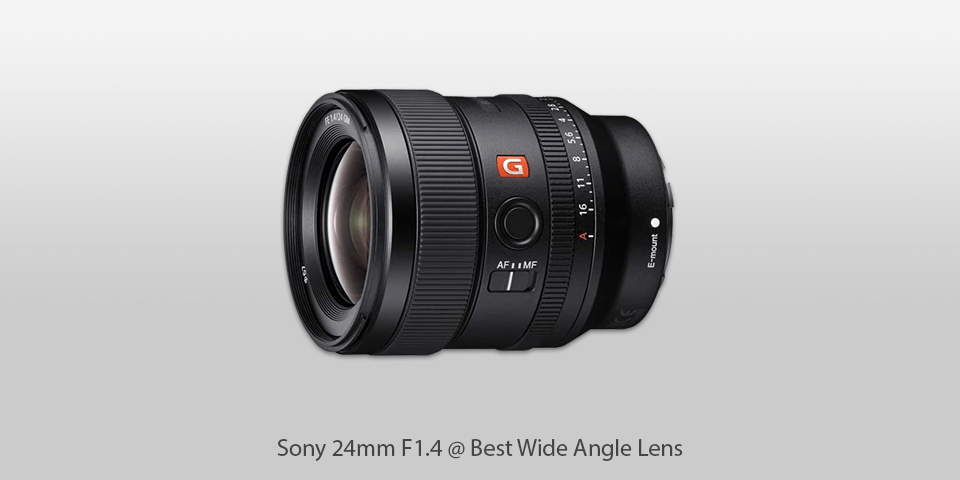
Mount: E| Diaphragm blades:11 | Autofocus:good | Min focus distance: 0.24 m | Max magnification: 0.17x | Filter thread: 67 mm | Dimensions (WxL):24 mm | Weight: 445g
⊕ Lightweight and small
⊕ Dust, moisture, and fluorine resistance
⊕ Aperture ring allows selecting detents
⊖ Above-average price
Sony 24mm f/1.4 deserves to be among the best wide angle lenses due to its enhanced optics, 2 extreme aspherical components, and 3 extra-low dispersion glass components that provide terrific edge-to-edge resolution even at the widest aperture setting. Equipped with an 11-blade circular aperture system it adds a beautiful bokeh effect that the G-Master series is famous for. The lens is powered by the Direct Drive SSM system, which ensures fast and precise focusing. It’s also pleasantly compact and light, allowing you to enjoy convenient handling and portability.
| Image | Name | Features | |
|---|---|---|---|
 |
Nikon 10-20mm f/4.5-5.6G
Our choice |
CHECK PRICE → | |
 |
Rokinon 14mm f/2.8-22
High quality |
CHECK PRICE → | |
 |
Canon 10-18mm f/4.5-5.6
Compact |
CHECK PRICE → |

You can always find out the max aperture of a DSLR wide angle lens in its description. This characteristic is determined by the amount of light that the lens can transmit to the camera’s sensor at its widest. If a lens can pass through a lot of light, you’ll be able to take beautiful photos even in poor lighting conditions without suffering from blur. Aperture is described as a number like f/2.8. The lower the aperture value, the more light your camera will receive. In theory, the best aperture would be 1, but such a level of light transmission is currently unattainable, which is why even the best lenses have a max aperture of about f/1.2. Most photographers are completely satisfied with apertures in the f/2.4-f/3.2 range and don’t go lower than that, since lenses with higher apertures cost less.
Telephoto lenses typically have bigger aperture values, while zoom models have two numbers in their descriptions (like f/2.8-5.6). The first number describes the amount of light received at its widest range while the second figure shows how much light is transmitted at maximum zoom.
The moment you purchase an interchangeable lens camera, you become tied to a specific manufacturer and all the lenses that are compatible with it. For instance, Nikon and Canon products are completely incompatible. Even though there are examples of 2 or more brands using the same mount (Micro Four Thirds by Panasonic and Olympus, or the L-mount being shared by Panasonic, Leica, and Sigma), usually you can’t just attach any lens you want to your camera. Even lenses made by the same brand have limited compatibility. For example, you can’t attach a Nikon DSLR lens to a mirrorless camera.
In most cases, the max zoom value of an interchangeable lens is about 10x, but that number differs for DSLRs, mirrorless, and point-and-shoot cameras. Interchangeable lens cameras have significantly bigger sensors that provide a higher quality picture compared to smaller models, but such a big sensor demands an equally big lens. That’s why compact cameras offer tremendous zoom power, while bigger models demand several lenses to provide the same range.
Fixed lenses are also called primes, as they are defined by their unchangeable focal length, with the most popular options being 35mm and 50mm. Since they don’t have zoom functionality, such lenses are easy to use and provide superior picture quality for a lower price. A 35mm prime lens is considered standard since it emulates what we see with our eyes. Prime lenses are a terrific choice for portrait photographers because they offer a larger max aperture and allow you to enjoy higher image quality compared to a wide angle zoom lens.
The EF 24-70mm f/2.8L II USM is often named the ultimate all-round choice for full-frame cameras. It offers unparalleled versatility and a consistent f/2.8 aperture at all zoom lengths. The lens’ autofocus is fast and silent, and you can easily go into manual focusing without changing the camera’s mode.
Sigma's 50mm f/1.4 DG HSM Art and the Zeiss Otus 55mm f/1.4 are the market leaders in terms of sharpness, but you can also get a Canon 35mm f/1.4 II USM, as the photos it produces end up looking just as sharp.
Your next stop should be a prime or a zoom lens, with most photographers usually choosing a zoom. A model such as the AF-S DX NIKKOR 10-24 mm f/3.5-4.5G ED is a good pick for Nikon camera owners, while people that have a Micro Four Thirds camera can go for an Olympus 9-18 mm f/4-5.6 ZUIKO lens.
Tamron products are typically cheaper than the ones made by Sigma, while also being faster, more lightweight, and quieter compared to Sigma lenses of the same class.
That said, Sigma also offers some terrific optics such as the Art series, although they do come at a higher price. In the end, the answer to this question comes down to your budget.

 Rating
Rating